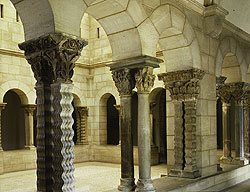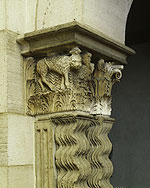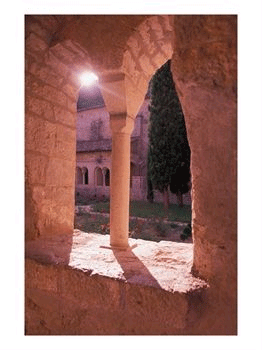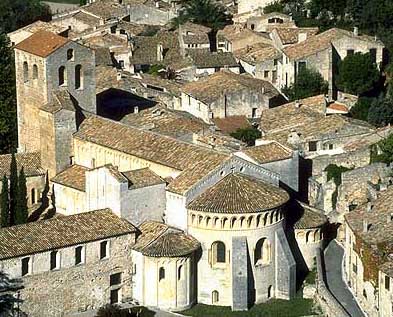
![]() The
Abbey is located in the town of
Saint-Guilhem-le-Désert in the Gellone Valley not far from Montpellier,
in the Hérault
département.
The
Abbey is located in the town of
Saint-Guilhem-le-Désert in the Gellone Valley not far from Montpellier,
in the Hérault
département.
It is a Benedictine foundation dedicated to Saint-Sauveur. It was founded in 804 by Guilhem of Orange, Duke of Aquitaine and second Count of Toulouse, a member of Charlemagne's court, later known as Saint Guilhem.
As the medieval pilgrimage route to the shrine of Saint James of Compostella in Spain developed in the 10th century, the monastery of Saint-Guilhem-le-Desert became a staging point on one of the four main routes through Europe leading to it. Like all such staging points it benefited financially from its more than usually gullible pilgrim visitors. By the middle of the 11th century the monks were rich enough to rebuild their monastery on a larger scale in the latest Romanesque style. The present abbey church dates from this period.
By the twelfth century, the abbey had been renamed in honour of its founder. And as the site in the Gellone Valley had been selected because it was a virtual desert, we now know it at the Abbey of Saint-Guilhem-le-Désert.
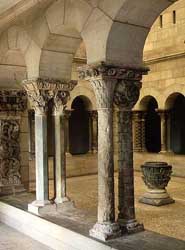
![]() By
1206, a new cloister had been built at Saint-Guilhem incorporating columns and
pilasters which are now located in an American museum. Many of them recall classical
Roman columns, but they depart from classical models in their variety of design.
By
1206, a new cloister had been built at Saint-Guilhem incorporating columns and
pilasters which are now located in an American museum. Many of them recall classical
Roman columns, but they depart from classical models in their variety of design.
During the 14th to 16th centuries, progressively declined. Under the 'commende' system the abbot was nominated by the king, who selected from among the members of the high clergy (rather than being elected by the monks of the community). The system inevitably led to abuse and for centuries successive Abbots from aristocratic families accumulated titles and neglected their monastic duties.
Like other French religious buildings, Saint-Guilhem suffered in the Wars of Religion during and after the Reformation. In 1569 the Abbey was pillaged by Protestants and sculptures were damaged. Furniture and fittings were sold off to pay for repairs, and for a garrison to protect the Abbey. By 1670 the monastery was in a state of advanced decay. The monks called upon the congregation of Saint-Maur to undertake repair work to save the buildings from ruin and re-establish the monastic life.
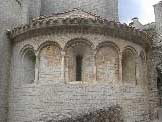
![]() The
abbey declined in the 18th century. In 1783, it was attached to the bishopric
of Lodeve, losing its independence. Monks from Saint-Maur occupied the monastery
until the French Revolution, by which time the community had been reduced to six
monks. It was suppressed in 1790 during the French Revolution, and the buildings
sold ominously to a stonemason. The abbey church escaped vandalism as it became
a parish church, but the rest was vandalised. Various businesses were established
in the cloister, including a spinning business and a tannery. Private houses were
established in the buildings around the cloister and the cloister itself which
was used as a stone quarry.
The
abbey declined in the 18th century. In 1783, it was attached to the bishopric
of Lodeve, losing its independence. Monks from Saint-Maur occupied the monastery
until the French Revolution, by which time the community had been reduced to six
monks. It was suppressed in 1790 during the French Revolution, and the buildings
sold ominously to a stonemason. The abbey church escaped vandalism as it became
a parish church, but the rest was vandalised. Various businesses were established
in the cloister, including a spinning business and a tannery. Private houses were
established in the buildings around the cloister and the cloister itself which
was used as a stone quarry.

![]() Fragments
of the abbey may be found all over the region, and even much further away. You
can see some of those columns of the cloister dating from before 1206 in the Cloisters
museum, north of New York (part of New York's Metropolitan Museum of Art). It
is difficult to know who best deserves the title of Most Cretinous Philistine
- the people who sold them, those who bought them, or those who now decline to
return them.
Fragments
of the abbey may be found all over the region, and even much further away. You
can see some of those columns of the cloister dating from before 1206 in the Cloisters
museum, north of New York (part of New York's Metropolitan Museum of Art). It
is difficult to know who best deserves the title of Most Cretinous Philistine
- the people who sold them, those who bought them, or those who now decline to
return them.
The cumulative damage of these various acts of vandalism was so severe that it is now impossible to determine the number and sequence of its columns - or even the dimensions of the cloister.

![]() In
1840, the abbey was taken in hand by the Monuments Historiques. Restoration since
1960 has tried to restore the original aspect of the building. A new cloister
has been built. Since the end of the 1970s, a community of monks from Carmel Saint
Joseph has made the abbey their home.
In
1840, the abbey was taken in hand by the Monuments Historiques. Restoration since
1960 has tried to restore the original aspect of the building. A new cloister
has been built. Since the end of the 1970s, a community of monks from Carmel Saint
Joseph has made the abbey their home.
The abbey is one of several World Heritage sites in the Languedoc. In 1987, the Abbey of Gellone was classed as a French Historical Monument. On the 5 December, 1998, it was classified as a World Heritage site by UNESCO as part of the "Paths of Saint James" - the pilgrimage routes of St-Jacques de Compostela
Here is an extract from the Met Museum's web page on the Saint-Guilhem-le-Désert's cloister:
|
|
